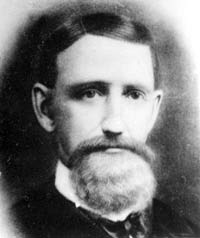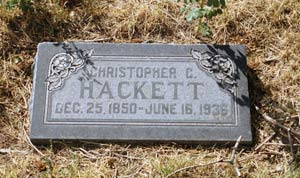by Junius Crossland
Banks
 Christopher Charles Hackett was of Irish descent, although born
at Liverpool, England. He was the thirteenth son born to Pierce and Mary Edwards
Hackett on Christmas Day, 1850. His mother declared that she wanted all boys
in her family and apparently her wish was granted. Four of the sons came to
America in 1850 to be followed by the remainder of the family the next year.
And so the Hackett family of father, mother, and ten sons was reunited, three
having died in infancy. The first home in the United States was established
at Independence, Missouri. The year following a house was made at Butler, Bates
County, of the same state. Pierce Hackett, the father, died in 1858 leaving
his widowed wife and ten sons.
Christopher Charles Hackett was of Irish descent, although born
at Liverpool, England. He was the thirteenth son born to Pierce and Mary Edwards
Hackett on Christmas Day, 1850. His mother declared that she wanted all boys
in her family and apparently her wish was granted. Four of the sons came to
America in 1850 to be followed by the remainder of the family the next year.
And so the Hackett family of father, mother, and ten sons was reunited, three
having died in infancy. The first home in the United States was established
at Independence, Missouri. The year following a house was made at Butler, Bates
County, of the same state. Pierce Hackett, the father, died in 1858 leaving
his widowed wife and ten sons.
When the Civil War broke
out in 1861, Missouri was more or less a divided state, some of its citizens
favoring the North and some the South. This same divided condition prevailed
among the boys of the Hackett family, in evidence of which four of the boys
joined the Union army and four the Confederate Army. It is not known if they
ever opposed each other in the same battles. It is hard to imagine the feelings
of the mother under these trying circumstances. Christopher, the subject of
this sketch, was too young to enlist.
While Christopher was growing
to manhood, Missouri was largely a frontier state. Educational opportunities
were limited. He, however, had a thirst for learning and attended school often
with children years younger than himself. He learned the trades of tailoring
and carpentry from his brothers.
During the California gold
rush, George Hackett, Christopher's brother, and two or three other men set
out for the golden state. Arriving in Utah, they camped for a few days' rest
at Spanish Fork. One of these days happened to be Sunday. An old lady and her
husband passed the camp of the travelers on their way to church. They stopped
to talk to the men, asking who they were and where they were going. Then George
told them that they were on their way to California, the old lady made this
significant statement, "You will never leave this Territory until you go
on a mission for the Mormon church." None of these men were Latter-day
Saints. In fact they were mostly Mormon-haters. Strange to say, however, it
turned out exactly as the old lady predicted. George became converted to the
Church, married a Latter-Day Saint girl and made a home at Alpine, Utah, and
from that ward went on a mission to Missouri where he converted his mother and
youngest brother, Christopher.
Upon receiving his release
from his missionary labors, George Hackett with his mother returned to his home
in Alpine, his brother Christopher following a year and a half later, making
his home also at Alpine for the next year. He then obtained work as a tailor
in Salt Lake City. Thither he moved, taking his mother with him. In 1880 he
moved to Lehi to operate Mulliner's flour mill at the site of what was later
the Lehi Sugar Factory.
On his thirty-first birthday
anniversary, December 25, 1881 Christopher was married to Margaret
Elsie Booth of Alpine by her brother, John Edge Booth. This couple was later
sealed, April 19, 1882 in the Salt Lake Endowment House. Their first two children,
Edna Myrtle
and May were born in Alpine, where Christopher operated a saw mill and worked
at carpentry. A move was then made to Wellsville Utah, where he again engaged
in flour milling for a period of four years. The family then moved to Rock Springs,
Wyoming, remaining for a year and a half while Christopher was employed as a
timberman in the coal mines. During these years the family increased apace.
It seems as though the
Hackett family did not remain in any one place for long. Following the brief
stay at Rock Springs, homes were established successively at Provo, Alpine,
Arimo, Idaho, Salt Lake City in three different locations, Alpine again, and
finally, Lehi.
Christopher Hackett was
naturally progressive and his life one of activity and usefulness. Seldom do
we find a person gifted in so many lines of endeavor, tailoring, carpentry,
milling both flour and lumber, farming, merchandising, casket making, and mining.
He owned the second automobile and was second to have plumbing in the home in
Alpine. He also had the first motor driven washing machine, the first concrete
walk and the second piano in this little community.
He was willing and dependable
as a church worker, holding with honor the following positions: President of
the Alpine Y. M. M. I. A., three times; Ward Clerk, Chairman of ward building
committee, ward teacher many years, chairman of Alpine Home Dramatic Club, chairman
of the Lehi Fifth Ward Genealogical Committee, Secretary of Lehi Stake High
Priest's Quorum, Keeper of Lehi baptismal records. He and his wife engaged in
much endowment work for the dead. In the fall of 1905 he accepted a call to
the North Central States Mission. He left a wife and eight children (with another
soon to come) to fill this appointment. The family had very limited means of
support. Edna, their oldest daughter, was teaching school. From her meager pay
she sent money to her father in the mission field and the rest went to the family,
but by dint of great sacrifice, the family survived and the mission was completed.
C. C. Hackett was a lover
of sports. His special interest was in basketball. He and his four sons issued
a challenge to any other family in Alpine to meet them on the basketball court.
The Don Strong family accepted the challenge but were easily defeated by the
Hacketts. He had the record of attending more state High School basketball tournaments
than any other fan.
 His last years were saddened
by the death of his wife to whom he has most devoted. After her passing he declared
himself to be "a lone man in a lone world". He could not content himself
with the families of any of his children and yet made a poor-out of doing for
himself. His unmarried daughter Maude came to his rescue for about the last
two years. He died at his home in Lehi the 16th of June 1936. Burial was in
the Alpine Cemetery.
His last years were saddened
by the death of his wife to whom he has most devoted. After her passing he declared
himself to be "a lone man in a lone world". He could not content himself
with the families of any of his children and yet made a poor-out of doing for
himself. His unmarried daughter Maude came to his rescue for about the last
two years. He died at his home in Lehi the 16th of June 1936. Burial was in
the Alpine Cemetery.
The children in order of
their birth were Edna, May, Maude, Charles, Richard, Allen, Ora, Rulon, Margaret,
and Joseph. At this writing (1958), four have passed on: viz., Edna, Maude,
Charles, and Richard.